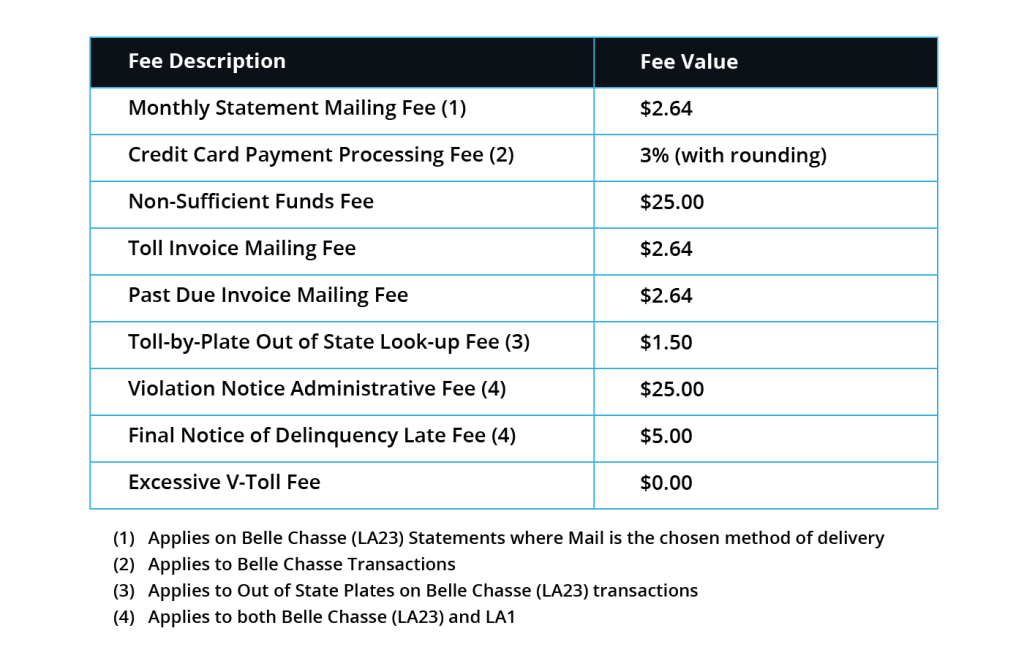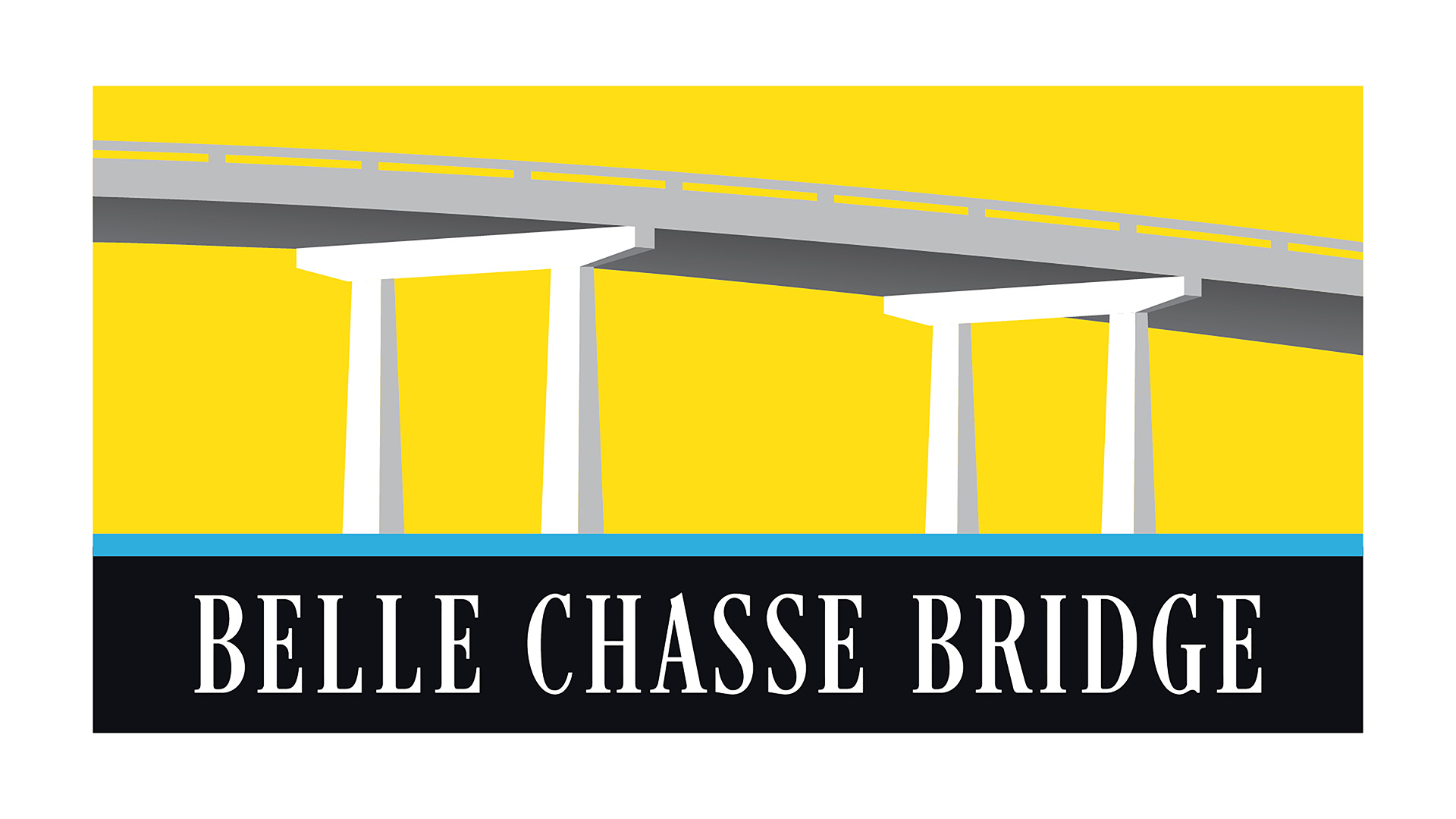The Plenary Infrastructure team began managing the Belle Chasse Tunnel and the Belle Chasse Bridge in April 2020. Construction of the new bridge will occur between 2020 and 2025. When the new bridge opens in 2025, both vehicles and marine traffic will have smooth access since the bridge will not lift to accommodate boats. The bridge is 73’ at its highest point, which will allow marine traffic to travel under without the bridge lifting. Tolling will start after the bridge fully opens all four lanes, expected to be in 2025. You won’t need to slow down or stop to pay the toll – a system of lights and cameras will capture your GeauxPass information and bill you electronically. Or, if you don’t have a GeauxPass, the tolling equipment will read your license plate and mail you a bill to the address on file with the DMV. Please note: if you do not have a GeuaxPass, you will pay a higher toll rate.
GeauxPasses will be available for free to the public. Please click here for more information on how to get your GeauxPass. Each vehicle needs its own GeauxPass, but you can easily bill multiple vehicles to one GeauxPass account. Using a GeauxPass gives you a lower toll rate in each category of vehicle size. To activate your GeauxPass, all you need to do is set up your account yourself online or with assistance from a GeauxPass Customer Service Representative by phone.
Residents of Plaquemines Parish with Class 1 vehicles who use a GeauxPass will pay a discounted toll rate of $0.25 per crossing. To qualify for this locals-only discount, you will need to set up your GeauxPass account and follow instructions to provide proof of your residency in Plaquemines Parish.
- To see vehicle category click here.
- It is important to note that the tolling rates listed below are from the CPI (Consumer Price Index, commonly known as inflation) Base Date of 2019. Toll rates will adjust with current inflation at the time the new Belle Chasse Bridge fully opens all four lanes, scheduled to be 2025 . CPI-based rates are expected to be higher in 2025 than those shown from 2019, and these rates may change yearly as inflation fluctuates. All categories of tolls are subject to increase except the Plaquemines Parish Residents with a GeauxPass category, which will remain $0.25 in 2025.
Certain groups are entirely exempt from tolling, determined by Louisiana state law, including:
- Law Enforcement Vehicles
- Emergency Vehicles
- Fire Departments*
- Disabled Veterans
- School Busses and Mass Transit Vehicles
- Parade or group transportation of the Boy Scouts of America, Girl Scouts of America, and Camp Fire Girls (minimum group size of 15 people)*
- * Indicates toll exemption will be applied manually by Customer Service Representative after customer contacts the Geaux Pass Customer Service Center and provides the required information for each relevant transaction.

Why was this project needed?
The project aims to address several needs:
- Reduce traffic delays caused by frequent bridge openings for passing vessels on the Gulf Intracoastal Waterway (GIWW). The Belle Chasse Bridge, with a height of 40 feet, opens often to accommodate marine traffic, causing traffic stoppages on Belle Chasse Highway.
- Minimize unplanned closures due to maintenance for both the bridge and tunnel, which are both over 50 years old. These closures cause traffic congestion and delays on Belle Chasse Highway, especially during tunnel cleanings.
- Enhance the efficiency and reliability of hurricane and tropical storm evacuation for both vehicles and vessels. The frequent bridge openings during these events create congested traffic on Belle Chasse Highway, affecting evacuation plans.
- Improve daily traffic flow on Belle Chasse Highway at the Gulf Intracoastal Waterway, considering future traffic demands estimated to increase from the current volume of around 34,633 vehicles per day according to the Regional Planning Commission’s Travel Demand Model.
How will this project benefit the community?
The new Belle Chasse Bridge aims to:
- Enhance access to Plaquemines Parish for both daily traffic and evacuation purposes, offering a reliable and efficient crossing over the Gulf Intracoastal Waterway. This improvement will reduce or eliminate delays caused by bridge operations and maintenance, benefiting residents and businesses.
- Enhance navigation on the Gulf Intracoastal Waterway by raising the bridge’s elevation, reducing delays caused by the current movable bridge for marine vessels.
- Support industrial growth by improving traffic flow on Belle Chasse Highway, meeting the needs of both residents and industries in the Parish.
- Adhere to financial limitations by ensuring affordability and alignment with objectives outlined in the Metropolitan Transportation Plan, considering funding capabilities.
Increase efficiency and decrease Operations and Maintenance (O&M) costs by allowing the Department of Transportation and Development (DOTD) to better allocate maintenance resources.
When will construction begin?
The plan for the new bridge involves surveying, engineering, and design work in 2020, construction started in 2021, and the new bridge ready for traffic by 2025. The old bridge and tunnel demolition should be finished by 2026.
Will access and traffic be impacted during construction?
Throughout the construction, there will be four lanes (two in each direction) available for crossing, except for occasional short-term reductions lasting a few hours.
When will the tolling start, and what will be tolled?
Tolls will be applied to the new Belle Chasse Bridge after it’s fully built and open for traffic in both directions, as outlined in the contract. This is anticipated to happen in 2025 . Click here for tolling rates and more information.
Will anyone be exempt from paying tolls?
According to Louisiana law, certain vehicles won’t need to pay tolls if they’re on duty and have a transponder.
- Law Enforcement Vehicles
- Emergency Vehicles
- Fire Departments*
- Disabled Veterans
- School Busses and Mass Transit Vehicles
- Parade or group transportation of the Boy Scouts of America, Girl Scouts of America, and Camp Fire Girls (minimum group size of 15 people)*
* Indicates toll exemption will be applied manually by Customer Service Representative after customer contacts the Geaux Pass Customer Service Center and provides the required information for each relevant transaction.
Do I have to stop to pay my toll?
No, all vehicles will pass through the toll area at the usual speed limit. Vehicles with GeauxPasses will be identified by the Automatic Vehicle Identification (AVI) system. Cameras will capture pictures of license plates for vehicles without a GeauxPasses to manage payments. This system is made to avoid causing delays in traffic. All GeauxPass payments will be collected electronically.
How do I get a GeauxPass for my vehicle?
As the bridge opening approaches, free GeauxPasses will be offered to the public at no cost for one year. You can order them online or get them from local events in Plaquemines Parish. There will likely be a small fee after the first year for new and replacement GeauxPasses.
Are there any additional GeauxPass account fees?
It is free to open a GeauxPass account. For each account funded with a credit card, a 3% processing fee will be charged to your Belle Chasse (LA23) transactions.

Retailer Payments
GeauxPass accounts funded by check, e-check, money order, or payments via the PayNearMe retail network do not incur card processing fees to your Belle Chasse (LA23) transactions but additional retailer convenience fees apply. PayNearMe participating retailers include Ace Cash Express, CVS, Dollar General Family Dollar, Walgreens and Walmart.
Fees depicted on the site are subject to change.
Will there be a discount for individuals who travel across the bridge multiple times a day?
No.
Will tolls be charged if there is a hurricane or evacuation?
During hurricanes, the bridge will stay open as long as it is safe to use. When a State of Emergency is declared, tolling will be temporarily lifted.
Will maritime vessels pay a toll?
No.
What makes up the toll rate we are paying?
The toll covers various expenses such as maintaining and operating the bridge, including the existing tunnel and bridge from 2020 to 2025, plus the next 30 years of maintaining the new bridge. It also covers costs for toll collection, operations, and repaying the money spent to build the bridge and demolish the old structures.
Is the DOTD making any financial contribution to the Project?
Additionally, DOTD will contribute $875,000 annually during the operating term, which prevents toll increases for local users with a transponder.
DOTD chose to use these funds specifically for the Belle Chasse project instead of directing them to other infrastructure needs in the State.
Who will own the new Belle Chasse Bridge?
Louisiana will own the new Belle Chasse Bridge, via LADOTD, and can enforce penalties and withhold payments if the private partner fails to meet its agreement obligations.
What benefit did the State of Louisiana gain when Plenary Infrastructure took over operations of the Belle Chasse Bridge & Tunnel in Spring of 2020?
Louisiana taxpayers do not have to pay for maintaining the old Belle Chasse bridge and tunnel once the Plenary team takes over these responsibilities.
Isn’t the private sector only involved in these P3 projects to make a profit?
Private companies create and construct infrastructure projects in both traditional and P3 models. In both cases, they aim to make a profit. However, in P3s, profits and losses are linked to how well the project performs. If the project isn’t finished on time or within budget, or doesn’t meet quality standards, the private partner might face financial penalties.
WHAT IS A P3?
The US Department of Transportation defines public-private partnerships (P3s) as agreements between public agencies and private entities to involve more private participation in transportation projects’ delivery and financing compared to the traditional method. Instead of separate contracts for design, construction, and maintenance, P3s involve long-term partnerships where private financing contributes to public infrastructure.
The Belle Chasse Tunnel & Bridge Replacement Project follows a P3 model called Design-Build-Finance-Operate-Maintain (DBFOM). This approach bundles responsibilities for designing, building, financing, maintaining, and operating the infrastructure, transferring them to private sector partners. DBFOM, also known as “concessions,” offers benefits such as cost savings, faster project completion, long-term maintenance, and transferring financial risks to private partners. It also provides access to new financing sources like private equity. The Belle Chasse project combines private funding, INFRA grant funding, and state and federal funding to move the project forward.
